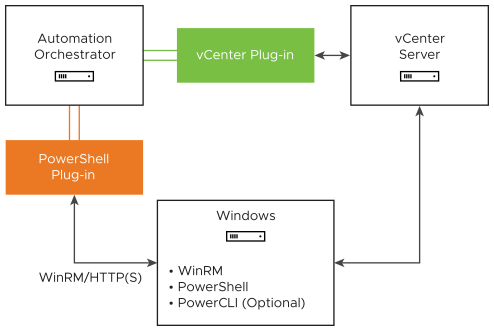The PowerShell plug-in allows interaction between Automation Orchestrator and Windows PowerShell. The PowerShell plug-in workflow library contains workflows that allow you to manage PowerShell hosts and run custom PowerShell operations.
You use the plug-in to call PowerShell scripts and cmdlets from Automation Orchestrator actions and workflows, and to work with the result. In addition to the standard workflows that come with the plug-in, you can also create custom workflows that implement the plug-in API.
You can use the Inventory view in the Automation Orchestrator Client to manage the available PowerShell resources. You can use the scripting API of the plug-in to develop custom workflows.
PowerShell plug-in components
The PowerShell plug-in relies on a number of components to function properly.
Automation Orchestrator and Windows PowerShell provide the platform for the plug-in, and the plug-in provides interaction between those products. The PowerShell plug-in can also interact with other components, such as vCenter and vSphere PowerCLI.

The plug-in communicates with Windows PowerShell through the WinRM communication protocol. See Configuring WinRM.
Optionally, you can integrate the PowerShell plug-in with vSphere PowerCLI and vCenter. See PowerCLI Integration with the PowerShell Plug-In.
You can install all components on a local host. The usage, functionality, and communication protocol requirements of the PowerShell plug-in do not change if Automation Orchestrator and Windows PowerShell are installed on the same machine.
Access the PowerShell plug-in API
To access the API Explorer from the Automation Orchestrator Client, click API Explorer in the Automation Orchestrator Client navigation pane.
To access the API Explorer from the Scripting tabs of the workflow, policy, and action editors, click Search API on the left.
You can copy code from API elements and paste it into scripting boxes. For more information about API scripting, see Developing with Automation Orchestrator.
Using the PowerShell plug-in inventory
The PowerShell plug-in exposes all objects in the connected PowerShell hosts in the Inventory view.
Within the inventory of the plug-in, you can monitor PowerShell hosts and their snap-ins and cmdlets. Each remote host can contain snap-ins and each snap-in can contain cmdlets.